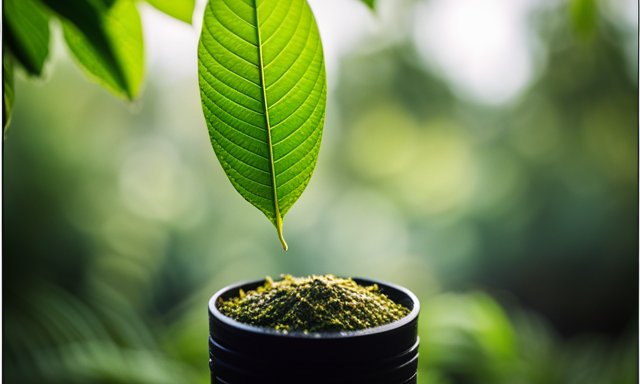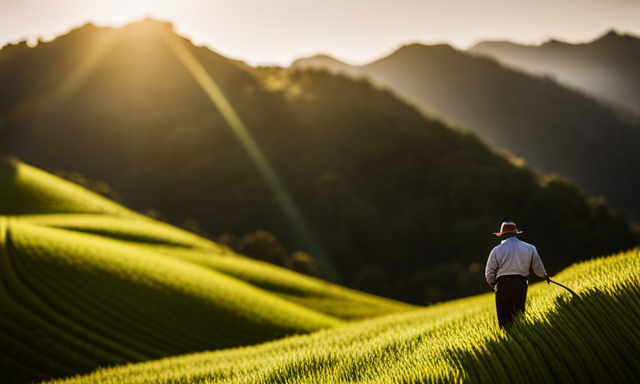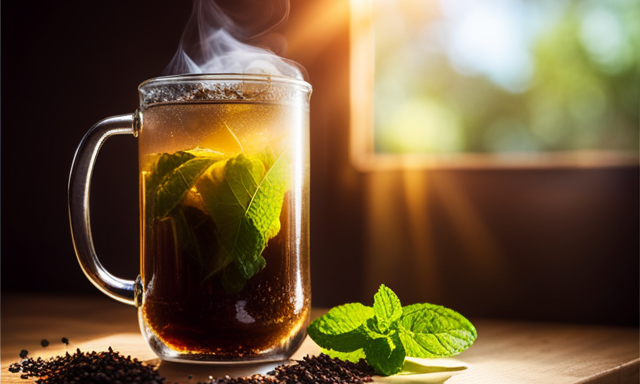Picture yourself nestled in a vibrant, green forest, enveloped by the calming echoes of the natural world. Inhaling deeply, you can nearly savor the rich, soil-like scent permeating the atmosphere. This is the realm of yerba mate leaves, an intriguing and adaptable herb that has enchanted societies for ages.
In this article, I will take you on a journey to explore the origins, harvesting methods, and preparation techniques of yerba mate leaves. We will delve into its unique flavor profile, its health benefits, and its role in traditional and modern culture.
From sustainability to culinary applications, we will uncover the many facets of this remarkable plant.
So grab a cup, settle in, and prepare to be amazed by the wonders of yerba mate leaves. Whether you are a seasoned enthusiast or new to the world of herbal infusions, this article will leave you with a deeper understanding and appreciation for this extraordinary botanical treasure.
Key Takeaways
- Yerba mate leaves are harvested from cultivated plantations in South America.
- The leaves are hand-picked and only mature leaves are selected.
- The leaves are dried using air drying or smoke drying techniques and then crushed and sifted to remove twigs and stems.
- Yerba mate leaves have a rich and full-bodied taste, combining the flavors of green tea and coffee, with characteristics such as earthy, herbaceous, bold, and smoky.
Origins of Yerba Mate Leaves
Yerba mate, scientifically known as Ilex paraguariensis, is a species of holly native to the subtropical regions of South America. It has a long history of cultural significance among the indigenous peoples of this region, particularly in countries like Argentina, Paraguay, and Uruguay.
The origins of yerba mate can be traced back to the Guarani people, who considered it a sacred plant and used it for medicinal and ceremonial purposes. Today, yerba mate leaves are harvested from cultivated plantations in these countries, using traditional methods that have been passed down through generations.
The leaves undergo a meticulous process of drying, aging, and grinding to produce the final product. With the knowledge of its origins and cultural significance, let’s delve into the fascinating world of yerba mate harvesting and processing methods.
Harvesting and Processing Methods
To get started, it’s important to learn about the various methods used to gather and prepare yerba mate for consumption. Harvesting techniques play a crucial role in obtaining high-quality leaves. The leaves are typically hand-picked from the yerba mate tree, ensuring that only the mature leaves are selected.
Once harvested, the leaves undergo a meticulous processing method to preserve their flavor and aroma. This involves drying the leaves using different techniques like air drying or smoke drying. After drying, the leaves are crushed and sifted to remove twigs and stems, resulting in a fine yerba mate powder.
Finally, the processed leaves are packaged and ready for consumption. Understanding the harvesting techniques and processing methods is essential for preparing a perfect cup of yerba mate.
Moving on to the subsequent section about ‘preparation and brewing techniques’, let’s explore the art of enjoying this invigorating beverage.
Preparation and Brewing Techniques
Get ready to experience the ultimate satisfaction by learning how to prepare and brew yerba mate leaves in a way that will transport you to a state of pure bliss. Brewing techniques vary depending on personal preference and the desired strength of the infusion. There are different varieties of yerba mate leaves available, each with its unique flavor profile and brewing requirements. To help you navigate the brewing process, here is a handy table outlining three popular brewing techniques:
| Brewing Technique | Water Temperature | Steeping Time |
|---|---|---|
| Traditional | 160-180°F | 3-5 minutes |
| Cold Brew | Cold water | 6-12 hours |
| Tereré | Ice-cold water | 5-10 minutes |
Experiment with these techniques to find the one that suits your taste preferences. Now, let’s explore the flavor profile and taste of yerba mate leaves.
Flavor Profile and Taste
Indulge in a sensory journey as you savor the enchanting flavor and invigorating taste of yerba mate, immersing yourself in a state of pure delight.
Yerba mate leaves offer a unique and complex flavor profile that combines the earthiness of green tea with the robustness of coffee. The taste is rich and full-bodied, with subtle notes of grass, herbs, and a hint of smokiness.
To fully experience the flavor characteristics of yerba mate, it is best to brew it at a temperature of 150-160°F for 3-5 minutes. This allows the flavors to fully develop without becoming bitter.
Here are four key flavor characteristics that define yerba mate:
-
Earthy: The earthy undertones give yerba mate a grounding and comforting taste.
-
Herbaceous: The herbal notes add a refreshing and invigorating element to the flavor.
-
Bold: Yerba mate has a bold and robust taste that lingers on the palate.
-
Smoky: The subtle smokiness adds depth and complexity to the overall flavor.
Transitioning into the subsequent section about the health benefits of yerba mate leaves, the unique flavor characteristics of yerba mate contribute to its overall appeal and make it a delightful beverage choice.
Health Benefits of Yerba Mate Leaves
Savor the enchanting flavor and invigorating taste of yerba mate as you discover the myriad health benefits it offers. Yerba mate leaves have gained popularity due to their numerous health benefits, leading to increased consumption worldwide. This traditional South American drink is rich in antioxidants, vitamins, and minerals, making it a potent source of nutrients. Research suggests that yerba mate may improve focus and mental clarity, boost energy levels, support weight loss, and strengthen the immune system. Additionally, it has been linked to reducing the risk of chronic diseases such as heart disease and diabetes.
To illustrate the various health benefits of yerba mate leaves, here is a table showcasing some of its key properties:
| Health Benefit | Description |
|---|---|
| Antioxidant-rich | Helps protect against oxidative stress and inflammation |
| Energy-boosting | Provides a natural source of caffeine and theobromine |
| Immune-boosting | Enhances immune function and aids in fighting infections |
| Weight management | May suppress appetite and promote fat burning |
| Mental clarity | Improves focus, concentration, and alertness |
As we delve into the nutritional value of yerba mate leaves, we will explore how these health benefits are derived from its unique composition.
Nutritional Value of Yerba Mate Leaves
The nutritional value of yerba mate leaves is fascinating. This traditional South American drink is packed with vitamins, minerals, and antioxidants, providing a healthy boost to your overall well-being.
Yerba mate leaves are rich in vitamins such as vitamin C, vitamin B1, and vitamin B2. These vitamins play crucial roles in maintaining a healthy immune system and promoting energy production.
They also contain minerals like potassium, magnesium, and manganese. These minerals are essential for proper bodily functions, including nerve function and bone health.
Moreover, yerba mate leaves are a great source of antioxidants. These antioxidants help protect the body against harmful free radicals and support cardiovascular health.
Additionally, yerba mate leaves contain caffeine. This provides a natural energy boost without the jitters associated with coffee.
Transitioning to the next section about yerba mate in traditional and modern culture, this nutritional powerhouse has not only nourished generations but also become a symbol of social connection and tradition.
Yerba Mate in Traditional and Modern Culture
Immersed in both traditional and modern culture, yerba mate has become a symbol of social connection and a cherished part of daily life. In social gatherings, it is common to see people passing around a gourd filled with yerba mate, sharing the drink and engaging in lively conversations. The act of preparing and sharing yerba mate has a communal aspect that fosters a sense of togetherness and bonding among friends and family.
Furthermore, yerba mate has gained popularity in the world of sports and fitness. Its natural stimulant properties, combined with its rich nutritional profile, make it a popular choice among athletes and fitness enthusiasts. Yerba mate provides a gentle, sustained energy boost without the jitters or crash associated with other caffeinated beverages. Its high antioxidant content also supports recovery and helps reduce inflammation.
As we explore the various aspects of yerba mate, it is important to consider its impact on the environment. Transitioning to the next section, we will delve into the topic of yerba mate and sustainability.
Yerba Mate and Sustainability
Yerba Mate in Traditional and Modern Culture has a rich history of consumption and social significance. However, it is important to consider the environmental impact of its production.
Yerba mate is grown mainly in South America, where sustainable farming practices are crucial to preserve the delicate ecosystems in which it thrives. Sustainable farming practices, such as organic cultivation, agroforestry, and water conservation techniques, are being implemented to minimize the environmental footprint of yerba mate production. These practices ensure that the biodiversity of the region is protected, while also promoting the long-term viability of the yerba mate industry.
By adopting sustainable farming practices, we can ensure that future generations can continue to enjoy yerba mate without harming the environment. Moving forward, it is essential to explore the potential of yerba mate in culinary applications while still considering its sustainability.
Yerba Mate in Culinary Applications
While savoring the invigorating flavor of yerba mate, chefs are discovering new ways to incorporate its unique taste into a variety of culinary creations. Yerba mate’s distinct herbal notes and subtle bitterness make it a versatile ingredient in both sweet and savory dishes. In desserts, yerba mate can be infused into ice creams, custards, and cakes, adding a delightful depth of flavor. When it comes to cocktails, yerba mate can be used to create refreshing and complex beverages. Its earthy undertones pair well with fruity flavors or can be combined with spirits for a more robust drink experience. By exploring different varieties and blends of yerba mate, chefs can unlock a world of exciting culinary possibilities.
Exploring Different Varieties and Blends
In exploring different varieties and blends of yerba mate, we will delve into the world of traditional yerba mate. This is the purest form of the beverage, made from the dried leaves and stems of the yerba mate plant.
Flavored and herbal blends, on the other hand, offer a variety of taste profiles. These blends incorporate different ingredients such as fruits, herbs, and spices.
Traditional yerba mate
Sipping on a steaming cup of traditional yerba mate is like wrapping yourself in a cozy blanket on a cold winter day. The rich, earthy aroma and deep, robust flavor of this South American beverage instantly transport me to a tranquil state of mind.
Traditional brewing methods, such as using a gourd and a bombilla, add to the allure of yerba mate, making it a truly unique experience. The yerba mate rituals, passed down through generations, create a sense of community and connection.
- The first sip brings a burst of energy, awakening the senses.
- The warmth of the drink spreads through the body, comforting and soothing.
- The bitter undertones are balanced by a subtle sweetness, creating a harmonious blend of flavors.
As I delve into the world of flavored and herbal blends, the possibilities for new taste experiences await, but the allure of traditional yerba mate remains strong.
Flavored and herbal blends
Indulging in flavored and herbal blends is like embarking on a taste adventure, where each sip is a delightful surprise that tickles the taste buds. These blends take the traditional yerba mate experience to new heights by infusing it with various flavors and herbal infusions. The combination of yerba mate leaves with fruits, spices, and herbs creates a unique and invigorating drinking experience. Whether you prefer the zesty tang of citrus or the soothing aroma of chamomile, there is a flavored blend to suit every palate.
To illustrate the range of options available, here is a table showcasing some popular flavored and herbal blends:
| Flavored Blends | Herbal Infusions |
|---|---|
| Citrus Burst | Chamomile Dream |
| Tropical Paradise | Minty Fresh |
| Berry Bliss | Lavender Serenity |
| Spiced Chai | Ginger Zing |
These blends not only offer a burst of flavor but also provide the same energizing effects and health benefits as traditional yerba mate. So, why not try a new twist on yerba mate and embark on a taste adventure with these delightful blends?
Frequently Asked Questions
Can yerba mate leaves be consumed in other forms besides brewing?
Yes, yerba mate leaves can be consumed in other forms besides brewing. They can be used to make yerba mate tea bags, capsules, extracts, and even added to foods and beverages for their health benefits.
Are there any potential side effects or risks associated with consuming yerba mate leaves?
Better safe than sorry! While yerba mate leaves have potential health benefits and cultural significance, it’s important to note that excessive consumption may lead to side effects like insomnia, increased heart rate, and potential risks of developing certain diseases.
How does yerba mate compare to other popular caffeinated beverages like coffee or tea?
Yerba mate offers a unique combination of caffeine and other beneficial compounds, making it a healthier choice than energy drinks. Compared to matcha, yerba mate provides a similar energy boost but with a different flavor profile and nutritional content.
Can yerba mate leaves be used in skincare or beauty products?
Yerba mate leaves can indeed be used in skincare and beauty products. They offer numerous benefits such as antioxidant properties, promoting collagen production, and reducing inflammation. DIY yerba mate face masks and scrubs can be made for glowing and rejuvenated skin.
Are there any specific guidelines or recommendations for storing yerba mate leaves to maintain their freshness and flavor?
To maintain the freshness and flavor of yerba mate leaves, it is important to store them properly. Follow these storage recommendations: keep them in an airtight container, away from light and moisture, at a cool temperature of around 60-70°F.
Conclusion
As I conclude my exploration of yerba mate leaves, I’m filled with a sense of reverence for this remarkable plant. Yerba mate has woven its way into the fabric of traditional and modern cultures, offering a symphony of flavors and health benefits. Its sustainable cultivation practices symbolize harmony between humans and the environment.
Sipping on my cup of yerba mate, I’m reminded of the rich history and diverse blends that await those who embark on this flavorful journey.










